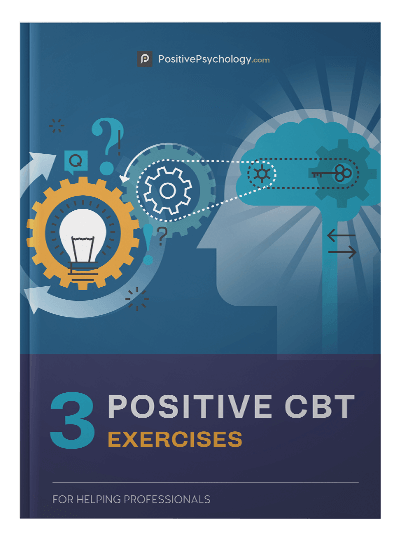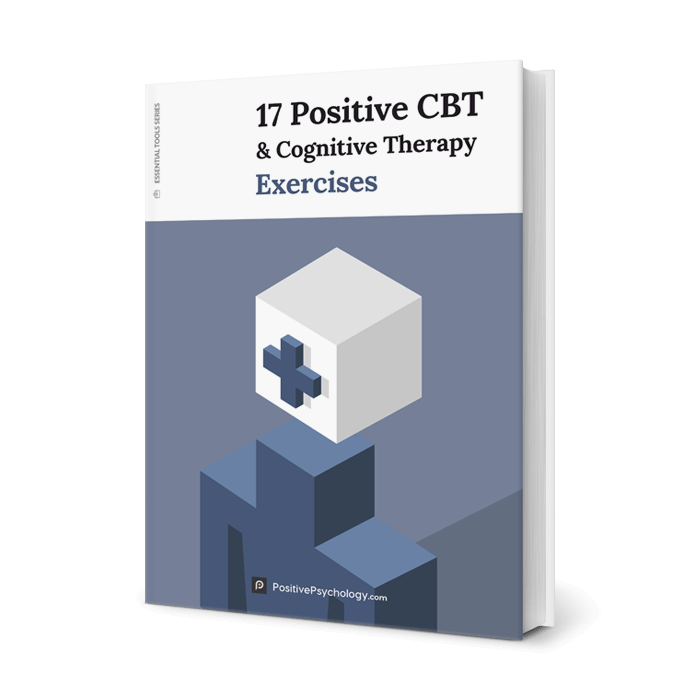Thought Records in CBT: 7 Examples and Templates
 The idea that our thoughts determine how we feel and behave is the cornerstone of Cognitive-Behavioral Therapy (CBT).
The idea that our thoughts determine how we feel and behave is the cornerstone of Cognitive-Behavioral Therapy (CBT).
The good news is that by helping people view experiences differently and changing how they think, we can alter how they react. This shift in perception can offer clients the opportunity to gain control and handle situations more effectively.
But first, it is vital to capture negative and unhelpful thinking accurately. In this article, we explore how to do that using Thought Records and introduce examples, tips, and techniques that can help.
Before you continue, we thought you might like to download these three Positive CBT Exercises for free. These science-based exercises will provide you with detailed insights into Positive CBT and give you the tools to apply it in your therapy or coaching.
This Article Contains:
What Is a Thought Record and Does It Work?
Unlike some forms of psychoanalysis, Cognitive-Behavioral Therapy does not focus on the past. Instead, while acknowledging the importance of earlier experiences, CBT recognizes that our current thinking shapes how events are perceived (Wilding, 2015).
Perceptions are often more crucial than actual events.
CBT addresses our current irrational, illogical, and incorrect thinking. It offers a well-researched and widely validated tool for treating anxiety, stress, and many other mental health issues (Widnall, Price, Trompetter, & Dunn, 2019).
The strength of CBT comes from it being both short term and solution focused. People also get the commonsense approach of CBT. This is essential as, according to the American Psychological Association (2017), CBT “emphasizes helping individuals learn to be their own therapists.”
While CBT can be understood by the untrained, complex and persistent problems typically require a professional’s support to make negative automatic thoughts visible and learn better ways of coping.
How do we recognize negative thinking?
Negative (and illogical and incorrect) thinking is likely to stop us from reaching short-term and life goals.
CBT does not suggest we try to block such thoughts, but rather identify them before considering their accuracy and effectiveness. Unhelpful ones can be reevaluated and replaced with thoughts that are rational and open minded.
Negative thoughts can take many forms yet often arise from specific types of thinking, for example (Wilding, 2015):
- You believe you know what others are thinking
- You expect disaster
- You tend to personalize general comments
- You generalize specific incidents
- You blame others for your thoughts and actions
As opposed to positive or even neutral thinking, such thought patterns lead us to interpret events negatively; in the long term, they can lead to depression and anxiety.
Such cognitive distortions are often automatic; they pop into our heads, unannounced and unwanted, and linger. They profoundly affect how we feel, with thoughts such as “I can’t cope” or “I feel awful,” and how we behave by avoiding opportunities and situations.
How do we capture negative thinking?
It can be useful to check in and ask ourselves if our thoughts are positive and constructive or negative and damaging throughout the day.
A simple example is given below (modified from Wilding, 2015):
| Process | Example |
|---|---|
| Event: What happened? | I said “hello” to an old friend, and she ignored me. |
| Thoughts: What went wrong? | She doesn’t like me since she moved up in the world. |
| Feelings/physical sensations: How do I feel? Are there any physical sensations? | Upset, angry, heaviness |
Does it work?
Once identified, Thought Records (TRs) provide a practical way to capture unhelpful thinking for functional analysis and review (Beck, 2011).
Indeed, TRs are potent tools for evaluating automatic thoughts at times of distress and remain a popular choice for therapists.
Research has confirmed that TRs are highly successful at effecting belief change and are recommended for CBT practitioners working with a client (McManus, Van Doorn, & Yiend, 2012).
How Are Thought Records Used in CBT?

Completing a thought record
The more often clients practice completing TRs, the greater their awareness of negative or dysfunctional thinking.
A good time to complete a TR is shortly after noticing a change in how we feel.
Begin by asking the client to consider the following questions regarding the thinking behind a recent emotional upset, difficult situation, or concern (modified from Beck, 2011):
- Is there any evidence to support this idea?
- What is the evidence for and against it?
- Are there other explanations or viewpoints?
- What is the worst that could happen, and how would I cope?
- What is the best that could happen?
- What outcome is most realistic?
- What is the result of such automatic thinking?
The following questions encourage us to start considering how we can challenge our thinking:
- What would happen if I changed my thinking?
- What would I tell a close friend if they were in this situation?
- What should I do next?
While automatic thoughts may have some supporting evidence, that evidence is typically inadequate and inaccurate and ignores evidence to the contrary.
When ready, ask your client to complete a Thought Record Worksheet, describing:
- A situation that led to unpleasant feelings (e.g., being turned down for a job)
- The negative thoughts that arose (I’m useless)
- The emotions running through your mind (I’m ashamed)
- Your response (blame interviewer, stop applying for jobs)
- A better, more adaptive response (ask for feedback from the interviewer)
Thought challenging
Our thinking style is influenced by inherited personality traits, upbringing, and meaningful events and interprets what we experience. Two people can have precisely the same encounter yet respond very differently.
CBT is a practical way to identify and challenge unhelpful thought patterns.
Thought challenging begins with focusing on the most powerful, negative thoughts captured in the TR Worksheet.
Ask your client to complete the first few columns in the Thought Record Worksheet, describing the situation in question. Here again is an example (modified from Wilding, 2015).
| Process | Example |
|---|---|
| Event | I said “hello” to an old friend, and she ignored me. |
| Negative thought(s) | She doesn’t like me anymore since she’s moved up in the world. |
| Negative feeling(s) | Upset, anger, heaviness |
Is there anything you could do differently in the future? For example, rather than jumping to conclusions, challenge your thinking with questions.
| Questions | Responses |
|---|---|
| Is there another way to look at this? | She didn’t see me, or she had other, more important, things on her mind. |
| How do I feel now? | Calmer and more forgiving |
With practice, such a change in thinking can become second nature. And the act of challenging thoughts will increasingly become internalized, with no need to write them down.
You don’t need to remove all negative thinking; instead, you are trying to find a more balanced outlook.
When stressed or having a bad day, we are more likely to reject the positives and only see the negatives.
Real-Life Example
Sally is with her therapist and has already been asked to consider a set of questions similar to those above to evaluate her thought “Bob won’t want to go out with me” (modified from Beck, 2011).
Taking one column at a time, she completes a TR, including percentage scores to indicate likelihood or intensity:
| Thought Record Example | |
|---|---|
| Date/Time | Friday, August 3, at 3 pm |
| Situation | Thinking about asking Bob if he wants to go for a coffee |
| Automatic thoughts | He won’t want to go with me – 90% (likelihood score) |
| Emotions | Sad – 75% (intensity score) |
Sally was then asked to consider what cognitive distortion category her thinking might fall into (in this case, it’s fortune telling or mind reading). She assumed that she knew what Bob was thinking, but she didn’t.
Questions
Next, Sally was asked to consider the following set of questions, write down her thoughts, and rate the likelihood (%) of each one:
- What is the evidence that the automatic thought is true?
- Is there a different explanation?
- What’s the worst (and best) that could happen?
- What’s the most likely outcome?
- What’s the effect of believing this automatic thought?
- How could changing my thinking help?
- What should I do about it?
- What would you say to a friend?
Adaptive responses
- I don’t really know if he wants to go or not (90%).
- He is friendly to me in class (90%).
- The worst that will happen is that he will say no, and I’ll feel bad for a while, but I could talk to my friend Alison about it (90%).
- The best is that he will say yes (100%).
- The most realistic outcome is that he will say he’s busy but still be friendly to me (80%).
- If I keep assuming he doesn’t want to go with me, I won’t ask him at all (100%).
- I should just go up and ask him (50%).
- What’s the big deal anyway (75%)?
Lastly, Sally was asked to rate how much she now believes the automatic thought, how intense her sadness is, and what she would do next.
Outcome:
- Automatic thought – 50%
- Sad (emotion) – 50%
- I’ll ask him
Completing a TR will not remove all negative emotions, but even reducing their impact by a small amount makes the effort worthwhile.
3 Tips for Thought Catching

1. Complete the TR in stages
Most clients find that TRs are incredibly useful for organizing their thoughts and considering their responses.
However, if less daunting or confusing, ask the client to complete the first four columns (date and time, situation, automatic thoughts, and emotions) in one session, and then the last two columns (adaptive response, outcome) in the next session (Beck, 2011).
2. TR alternative
TRs aren’t the only way to capture thoughts. The following questions can be used to replace the worksheet and more easily guide the client as they challenge a thought (modified from Beck, 2011):
- What is the situation? My friend didn’t call.
- What am I thinking? She doesn’t like me anymore.
- Why do I think this is true? She said she would call.
- Why might this not be true? She has forgotten to call in the past, and her mother is not well.
- What’s another way to look at this? Something important came up.
- What’s the worst outcome? She stops being my friend, and I focus on my other friends.
- What’s the best outcome? She will call and say she is sorry, but something came up.
- What will probably happen? She will call and tell me she lost her phone.
- What will happen if I keep reacting in this way? I will keep getting upset and push friends away.
- What could happen if I changed my thinking? I could feel better and check if she is okay.
- What would I tell a friend if this happened to them? Give the person extra time to call, or call to see if everything is okay.
3. Positive and negative event TRs
We don’t have to limit our focus to negative TRs; it can be useful to explore positive ones too (Wilding, 2015):
Choose a recent event and complete a TR that also includes:
- Positive thoughts – I’m excited about my new job.
- Neutral thoughts – What am I going to have for dinner?
- Evaluative thoughts – I wonder where I will sit in my new job?
- Rational thoughts – If it’s not the right job, I can always take another.
- Action-oriented thoughts – I’m determined to be good in my new job; if I need to do some extra hours to catch up, then that’s okay.
It’s useful to understand multiple categories of thoughts. It is then easier to spot the negative ones; for example, I will be useless in the job, and they only gave it to me because no one else showed up.
Negative thoughts are the ones that will leave you feeling upset, unhappy, and anxious.
3 Steps of thought journaling using CBT – The Lukin Center
Thought Records for Anxiety and Depression
Reviewing our TRs is a vital exercise for recognizing repeating negative (or unhelpful) behavioral patterns.
Anxiety
We may spot the signs of anxiety – difficulty focusing and sleeping, feeling on edge – as we review our thoughts and responses.
Perhaps rather than addressing an issue, we reduce the unwanted symptoms through avoidance. We may decline invitations to social events or refuse to apply for more senior positions at work.
While such coping mechanisms may stop us from feeling bad, they do not solve underlying problems (Wilding, 2015).
As we assess our thoughts, it can be worth asking if this will make me feel better or get better. If it is the former, it can be worth seeking other ways of addressing feelings of anxiety, such as relaxation or working on our coping techniques.
Depression
Depression can leave us exhausted. Constant tiredness and staying in bed can all be signals to watch out for when reviewing TRs.
We may misguidedly think that additional rest will mean we are more ready for the world from which we are hiding. So, we avoid the effort of doing things. We call in sick, tell friends we can’t make social events, and miss the office party.
And yet, this behavior reinforces our negative feelings. If we don’t show up, we start to believe that no one notices or cares that we are absent. We are strengthening the negative.
Wilding (2015) describes this as the all-too-much error and suggests that the answer can come from adopting a do-the-opposite approach.
By first being aware of these negative thoughts while reviewing TRs, behavior can be turned on its head. Going into work and accepting the invitation can build mastery over emotions and an all-important sense of control.
6 Template Worksheets

Thought Record Worksheet
This Automatic Thought Record Worksheet provides an excellent way to capture faulty thinking and begin the process of cognitive restructuring.
‘Mood first’ thought record
The following variation on the TR theme provides a simple way to record feelings, situations, and automatic thoughts in one place.
| Feelings (one word) | Situation (actual or imagined) |
Automatic thoughts (first thoughts before you started to feel this way) |
|---|---|---|
| Fearful | Offered a new role at work | I can’t take on new responsibilities. |
| Irritated | Offered a new role at work | That wasn’t the role I wanted or deserved. |
| Excited | Offered a new role at work | I may be able to travel more and get a raise. |
If there are multiple, automatic thoughts for the same situation, circle the strongest one (for example, I can’t take on new responsibilities). Focus on the thoughts and feelings that upset you the most and give them a score (fearful 60% and irritated 40%).
The thought that scores the highest is the causal thought – the base thought that caused the emotions – and should be addressed first.
Assess cognitive distortions
Review the TRs and complete the Exceptions to the Problem Questionnaire to understand how each one could be responded to differently. What happened when things were better?
Finding Discrepancies
Use the Finding Discrepancies Worksheet to challenge negative thoughts.
Understanding the impact of continuing with existing behavior is extremely valuable. What happens if I continue as I am versus taking a new, healthier approach?
Cognitive Restructuring Worksheet
Use Socratic questioning in the Cognitive Restructuring Worksheet to challenge irrational or illogical thinking. For example, ask yourself:
- Could I be misinterpreting the facts?
- How likely is this scenario?
- Could others have different perspectives?
Once complete, clients can determine whether they are misinterpreting facts or repeating a habit.
Facts or opinions
We often mistake subjective opinions for facts, leading to cognitive distortions about ourselves.
Use the Facts or Opinions Worksheet to practice how to differentiate between opinion and fact.
Additional PositivePsychology.com Tools
PositivePsychology.com is a great source of information and help for Positive CBT.
The Positive Psychology Toolkit© provides various worksheets and exercises designed to help individuals conquer negative thinking.
If you’re looking for more science-based ways to help others through CBT, this collection contains 17 validated positive CBT tools for practitioners. Use them to help others overcome unhelpful thoughts and feelings and develop more positive behaviors.
A Take-Home Message
Cognitive-Behavioral Therapy provides a practical way to identify and challenge illogical and incorrect thought patterns.
To address a person’s unhelpful and often untrue beliefs, we must first capture their thoughts accurately and in sufficient detail. Thought Records are an invaluable and proven aid in capturing automatic thinking that can plague us and appear believable, despite being unreliable (McManus et al., 2012).
Paying attention to what is running through our minds – thoughts and pictures – when feelings and situations change can become a positive habit, helped by writing them down.
Capturing the situation, thought, and emotion to check its accuracy begins the process of changing the way we think.
Is there a more helpful way to think about myself and what has happened? Most likely, yes.
Use Thought Records to collect data about your clients’ specific thoughts, emotions, and behaviors, and plan a strategy for overcoming their difficulties. Include problem solving and changes to thinking and behavior to help them build a better life.
We hope you enjoyed reading this article. For more information, don’t forget to download our three Positive CBT Exercises for free.
- Beck, J. S. (2011). Cognitive behavior therapy: Basics and beyond. Guilford Press.
- McManus, F., Van Doorn, K., & Yiend, J. (2012). Examining the effects of thought records and behavioral experiments in instigating belief change. Journal of Behavior Therapy and Experimental Psychiatry, 43(1), 540–547.
- American Psychological Association (2017). What is cognitive behavioral therapy? Clinical Practice Guideline for the Treatment of Posttraumatic Stress Disorder. Retrieved November 12, 2020, from https://www.apa.org/ptsd-guideline/patients-and-families/cognitive-behavioral
- Widnall, E., Price, A., Trompetter, H., & Dunn, B. D. (2019). Routine cognitive behavioural therapy for anxiety and depression is more effective at repairing symptoms of psychopathology than enhancing wellbeing. Cognitive Therapy and Research, 44, 28–39.
- Wilding, C. (2015). Cognitive behavioural therapy: Techniques to improve your life. Quercus.
Let us know your thoughts
Read other articles by their category
- Body & Brain (49)
- Coaching & Application (57)
- Compassion (26)
- Counseling (51)
- Emotional Intelligence (24)
- Gratitude (18)
- Grief & Bereavement (21)
- Happiness & SWB (40)
- Meaning & Values (26)
- Meditation (20)
- Mindfulness (45)
- Motivation & Goals (45)
- Optimism & Mindset (34)
- Positive CBT (28)
- Positive Communication (20)
- Positive Education (47)
- Positive Emotions (32)
- Positive Leadership (18)
- Positive Parenting (4)
- Positive Psychology (33)
- Positive Workplace (37)
- Productivity (16)
- Relationships (46)
- Resilience & Coping (36)
- Self Awareness (21)
- Self Esteem (37)
- Strengths & Virtues (31)
- Stress & Burnout Prevention (34)
- Theory & Books (46)
- Therapy Exercises (37)
- Types of Therapy (64)





What our readers think
Thank you for all the information
What happened? I was not able to download the PDF of worksheets from your newsletter. Indicated the email address had already been used. Of course it has!! I get your newsletter!!!!
Hi Mary,
Thanks for reaching out – we are sorry that you are experiencing this! If you have still not received the worksheets, please email our customer support team at info@positivepsychology.com, and they will help you immediately!
Kind regards,
-Caroline | Community Manager
Thank you! The article was very insightful. The process to challenge the negative thinking so beneficial. I intend to read it again.
It was very useful.I feel use of CBT will certainly help a person to think in different ways whichvwill help them to be at peace.Thank you foe providing examples to understand the process of CBT.
How can we effectively use this technique to treat adults with mobile or TV addiction.
Hi Vatsala,
Glad you found the post useful. That’s a tricky question. Research on mobile and TV addiction is still in the early stages, so I’m not sure how much work is out there linking the practice of thought records to treating these addictions. You may find it helpful to do a search for CBT-IA (internet addiction), which will cover different CBT techniques that apply to internet usage (and mobile phones by extension). You’ll also find a review on treatments for television addiction here.
I hope this helps a little!
– Nicole | Community Manager
Thank you. It’s very practical skills.
I enjoy reading this article. Very insightful.
thanks so much for those examples. very easy way to understand CBT concepts.
Thank you a whole lot for reminding me of this valuable thought correction process.
Have a great day and year.